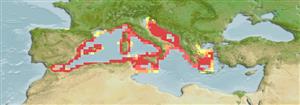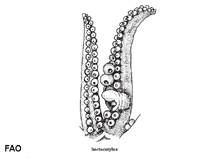Sepiola intermedia Naef, 1912
Intermediate bobtail squid| Native range | All suitable habitat | Point map | Year 2050 |

|
| This map was computer-generated and has not yet been reviewed. |
| Sepiola intermedia AquaMaps Data sources: GBIF OBIS |
Classification / Names Common names | Synonyms | CoL | ITIS | WoRMS
Cephalopoda | Sepiida | Sepiolidae | Sepiolinae
Environment: milieu / climate zone / depth range / distribution range Ecology
Benthic; depth range 8 - 200 m (Ref. 1695). Subtropical; 46°N - 35°N, 6°W - 26°E (Ref. 1695)
Distribution Countries | FAO areas | Ecosystems | Occurrences | Introductions
Mediterranean Sea.
Length at first maturity / Size / Weight / Age
Maturity: Lm ? range ? - ? cm Max length : 2.6 cm ML male/unsexed; (Ref. 1695); 2.8 cm ML (female)
Found mainly on muddy bottoms between 60 and 200 m depth throughout its distributional range. A preference for shallower, coastal and sandy bottoms have been observed in the Adriatic and Tyrrhenian Seas where it can be very abundant and often associated with Turritella communis, Astropecten bispinosus,and Ophiura texturata. Spawning period possibly prolonged based on the observation of mature individuals present throughout the year. Adults have been collected in midwater during night purse seine fishing for blue fishes, evidence of its strong swimming ability. Collected by local small-scale fisheries throughout its distributional range (Ref. 1695).
Life cycle and mating behavior Maturity | Reproduction | Spawning | Eggs | Fecundity | Larvae
Members of the class Cephalopoda are gonochoric. Male and female adults usually die shortly after spawning and brooding, respectively. Mating behavior: Males perform various displays to attract potential females for copulation. During copulation, male grasp the female and inserts the hectocotylus into the female's mantle cavity where fertilization usually occurs. Life cycle: Embryos hatch into planktonic stage and live for some time before they grow larger and take up a benthic existence as adults.
Main reference
References | Coordinator | Collaborators
Jereb, P. and C.F.E. Roper (eds.). 2005. (Ref. 1695)
IUCN Red List Status (Ref. 130435)
Data deficient (DD) ; Date assessed: 30 March 2009
CITES status (Ref. 108899)
Not Evaluated
CMS (Ref. 116361)
Not Evaluated
Threat to humans
Human uses
| FishSource |
Tools
More information
Internet sources
BHL | BOLD Systems | CISTI | DiscoverLife | FAO(Publication : search) | Fishipedia | GenBank (genome, nucleotide) | GloBI | Gomexsi | Google Books | Google Scholar | Google | PubMed | Tree of Life | Wikipedia (Go, Search) | Zoological Record
Estimates based on models
Preferred temperature
(Ref. 115969): 13.3 - 17.1, mean 14.5 (based on 83 cells).
Price category
(Ref. 80766):
Unknown.



